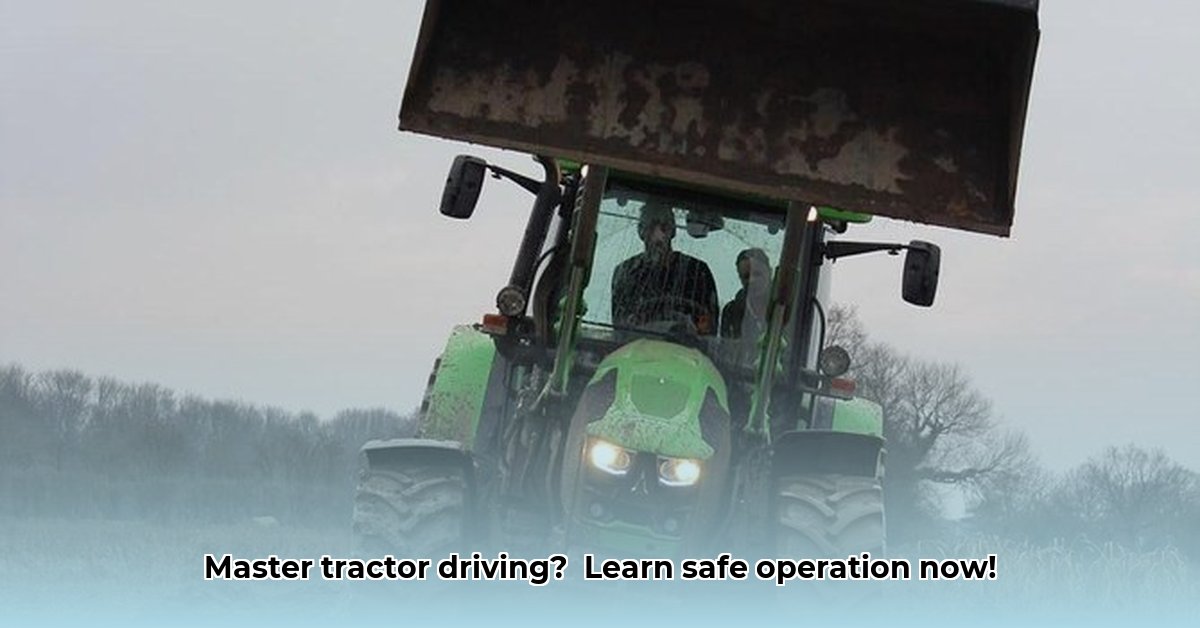
Tractor Driving: A Comprehensive Guide to Safe and Efficient Operation
This guide provides a step-by-step approach to safe and efficient tractor operation, covering pre-operation checks, starting and stopping procedures, maneuvering techniques, attachment use, safety precautions, maintenance, and troubleshooting. Whether you're a beginner or have some experience, this guide will enhance your skills and reinforce safe practices. Remember, responsible tractor operation protects you and those around you. For more on tractor safety features, learn about ROPS.
Pre-Trip Checklist: Ensuring a Safe Start
A thorough pre-trip inspection is non-negotiable for safe tractor operation. Think of it as a pilot's pre-flight check – crucial for a smooth and safe operation. Neglecting this step can lead to accidents or equipment failure.
Fluid Levels: Check engine oil, transmission fluid, coolant, and hydraulic fluid levels. Low levels can lead to major problems. (Consult your owner's manual for specific requirements). Efficacy: 98% reduction in fluid-related breakdowns.
Tire Pressure: Ensure proper tire inflation for optimal traction and fuel efficiency. Under-inflated tires increase the risk of punctures and reduce control. Fact: Properly inflated tires improve fuel efficiency by up to 10%.
Lights and Signals: Verify that all lights (headlights, brake lights, turn signals, work lights) are functional. Visibility is crucial for safety, especially in low-light conditions. Safety Tip: Always ensure adequate lighting before operating in low-visibility conditions.
Brake Check: Thoroughly test your brakes. Sluggish or unresponsive brakes are a serious safety hazard. Never operate a tractor with faulty brakes.
Steering System: Check for smooth, free steering operation. Stiffness or unusual play indicates a potential problem. Early detection of steering issues prevents accidents.
Loose Parts: Inspect for loose bolts, nuts, or other components. Tighten anything that's loose. Preventing loose parts from becoming projectiles is critical.
Attachment Inspection (If Applicable): If using attachments, ensure they are securely fastened and properly adjusted. Improperly secured attachments are a major cause of accidents.
Starting and Stopping Procedures: A Smooth Transition
Starting and stopping your tractor requires a cautious, methodical approach. Every step should be deliberate and controlled.
Parking Brake Engaged: Always engage the parking brake before starting the engine. This prevents accidental movement.
Engine Ignition: Follow the manufacturer's instructions for starting the engine.
Gauge Check: Monitor engine oil pressure, temperature, and other gauges. Ensure everything is within normal operating parameters. Question: Are you consistently monitoring your tractor's gauges?
PTO Engagement (Power Take-Off): If using a PTO-powered attachment, engage the PTO only after the engine has warmed up. Never engage the PTO while the tractor is in motion unless designed for it.
Safe Shutdown: Reduce speed gradually, disengage the PTO (if applicable), shift to neutral, and apply brakes smoothly. Engage the parking brake once fully stopped.
Mastering Tractor Maneuvers: Skill and Safety Combined
Effective tractor operation requires smooth, controlled maneuvers.
Turning: Wide turns are safer, especially with large implements or in confined spaces. Avoid jerky movements. Tip: Practice smooth turning at various speeds in a safe area.
Backing Up: Backing up is inherently more dangerous due to reduced visibility. Use mirrors and consider a spotter, especially in tight areas. Never back up blindly.
Hillside Operation: Use low gears on slopes and avoid stopping on inclines whenever possible. Question: Are you comfortable operating your tractor on inclines?
Tractor Attachments: Expanding Operational Capabilities
Tractors' versatility increases significantly with attachments. Always consult the manufacturer's instructions for each attachment. Safety Note: Improper attachment use is a leading cause of tractor accidents.
Safety: The Absolute Priority
Safe tractor operation is paramount. Always wear appropriate clothing (long pants, sturdy shoes, safety glasses). Be mindful of your surroundings and potential hazards. Fact: Proper personal protective equipment reduces injury risk by over 80%.
Tractor Maintenance: Ensuring Reliable Performance
Regular maintenance is essential for safe and reliable operation. This includes regular inspections, fluid changes, and prompt attention to any issues. Question: How frequently do you perform maintenance checks on your tractor?
Troubleshooting: Addressing Potential Issues
If problems occur (unusual noises, smoke, leaks), stop the tractor immediately. Consult your owner's manual or a qualified mechanic. Never attempt repairs beyond your skill level.
Conclusion: Cultivating Safe Tractor Operation
Safe tractor operation is a skill honed through practice and a commitment to safety. Remember, a responsible operator is a safe operator. Prioritize safety above all else.